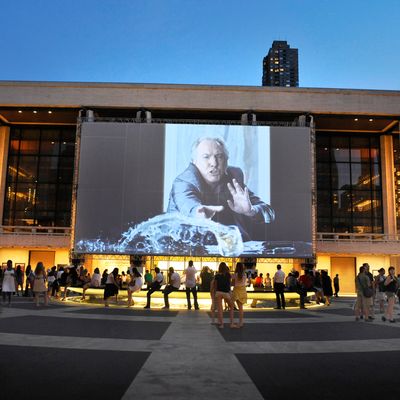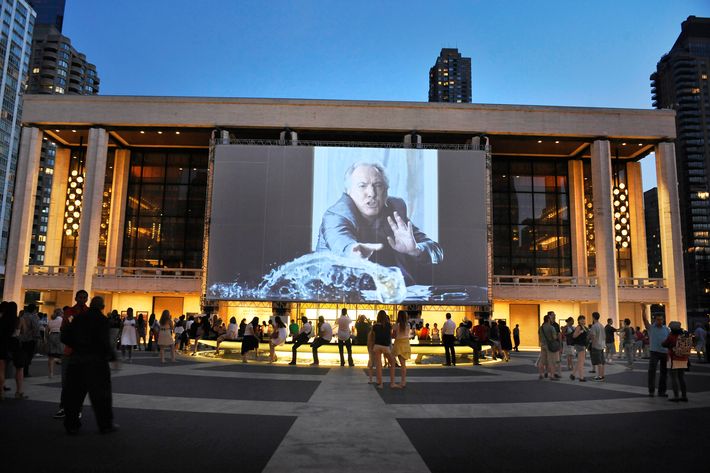

David Michalek, a photographer and visual artist, grins before the 60-foot-tall head of a very angry, very slow-moving Alan Rickman, who is projected onto a gigantic screen on the façade of the David H. Koch Theater at New York’s Lincoln Center on Tuesday night. It’s part of “Portraits in Dramatic Time,” a series of ultra-slow-motion video portraits of Rickman, William H. Macy, Holly Hunter, Liev Schreiber, and other actors livening up the plaza every night from 8:45 to 11:45 until the end of the month. The 45 portraits on view feature original scenes that took only ten seconds to make but are stretched to as long as ten minutes in length.To create the appearance of glacially slow movement, Michalek used an ultra-high-speed digital camera, recording at anywhere from 500 to 900 frames per second but playing them back at the usual 30. “This is weird. This is so weird. And great!” Michalek says, taking in his work. And he’s right: Even better is the next film, with a soaking wet, shirtless Macy violently flinging his body about, like a balletic head-banger. “Even as a young photographer,” Michalek says (he started out assisting Herb Ritts), “I was always trying to develop ways to get people comfortable so I could elicit a certain thing. You can’t tell someone ‘smile!’ or you get a fake smile. You have to create the conditions for laughter.”
Four years ago, Michalek used a prototype of a high-speed camera to realize his first slo-mo experiment: “Slow Dancing,” a similar installation focused on dancers and also shown on the Koch Theater’s façade. Working with actors for “Portraits” presented a different set of challenges. “Dancers kind of … dance themselves?” Michalek says (he knows: His wife is New York City Ballet principal Wendy Whelan). “I could tell them, ‘Please come to the studio with three five-second sequences prepared, each with a beginning, middle, and end, and let’s begin there.’ You can’t tell an actor to show up with that; you need to write a story and cast them in a scenario.” Rickman, who came to Michalek’s apartment after his run at BAM in John Gabriel Borkman, was desperate to escape the world of Ibsen. “He said, ‘We could start anywhere, couldn’t we? You just made me tea. Let’s begin with tea. I’m a guy drinking tea. Am I alone? How do I feel about the person across the table?’” (Rickman would go on to vengefully splash the tea, and when seen in thousand-fold relief, it elicits many oohs and aahs from the plaza audience.)
The unintentional result in these scenes, Michalek says, is “an inventory of emotional states. Part of what is amazing about [the camera] is it shows you moments inside of moments. Even though the actors may be directing themselves toward a certain end, every artificial moment has thousands of moments of truth within it. Shards of what the actor wasn’t intending show through.”
And the crowd on the plaza this muggy evening responds, transfixed. Take the next film up, one of two featuring Lili Taylor. It co-stars her young daughter, Maeve. Both are gazing at a newborn baby (the production designer’s): Taylor’s face is one of complete wonderment, but as her daughter shifts her gaze from the baby to mom, well, something else is going on.
A chorus of foreboding “Awwww”s waves across the plaza, and a friend calls out, “David, this is so heartbreaking!” And a stranger on the fountain yells, “That kid wasn’t acting — that girl is jealous!”
Taylor is currently in a play at the Williamstown Theatre Festival, and she hasn’t yet seen the portrait. “Was I able to convey any wonderment at all?” she asks anxiously over the phone the next day. “It’s so funny it got that reaction. It was like I was trying to act and be enamored with the little baby, but trying to keep Maeve on my lap and still. I don’t know how the hell I did it!”

